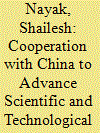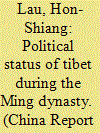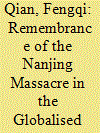| Srl | Item |
| 1 |
ID:
165270


|
|
|
|
|
| Summary/Abstract |
The development of a country is closely linked to investments made in science and technology as well as in social science and humanities. The investments made by China during last three decades in scientific research and technological innovation have led to flourishing industries and ultimately to economic development. India needs to enhance its investment in scientific research and innovation. However, unregulated development also leads to environmental and ecological issues. India and China are both actively addressing issues related to climate change. It may be worthwhile to develop a joint strategy by India and China to mitigate impacts of climate change. Another area where India and China can work together to understand the Himalayan eco-system as it affects many countries in this region. A formation of the Himalayan Science Council has been proposed to address issues related to glaciology, biodiversity, earthquakes and landslide as well as social and cultural issues. Such collaboration can be further advanced in the Arctic and Antarctica through the Asian Forum for Polar Sciences and influence Arctic and Antarctic research. The scientific leadership which India has in the Indian Ocean needs to leveraged for scientific diplomacy with China. Such scientific collaboration will not only help India and China but also contribute towards addressing regional and global scientific challenges.
|
|
|
|
|
|
|
|
|
|
|
|
|
|
|
|
| 2 |
ID:
165271


|
|
|
|
|
| Summary/Abstract |
This study analyses two authoritative texts and a map from the Ming and Qing eras to examine the political relationship between China and Tibet in the Ming period. It finds that in these documents Tibet was not classified as being a part of the realm governed by the Ming Empire. This casts doubt on the claim advanced by the People’s Republic of China that Tibet has been a part of China ‘since antiquity’. An important conclusion of this study is that, when taking recourse to historical texts to justify or refute territorial claims, the structure and content of the text as a whole, and not just isolated phrases or formulations, should be taken into account.
|
|
|
|
|
|
|
|
|
|
|
|
|
|
|
|
| 3 |
ID:
165267


|
|
|
|
|
| Summary/Abstract |
Victimisation is a pivotal theme in China’s new remembering of its War of Resistance against Japanese Aggression. While much of the world is talking about the rise of China, why are the Chinese still looking back to the nation’s sufferings in the past? This article investigates the development and dissemination of China’s collective memory of wartime victimisation, through a case study of the Nanjing Massacre Memorial. The article examines the ‘presentist’ use of the collective memory of victimisation in China’s era of opening up. It argues that the collective memory of victimisation is an emotional memory, evoked by new nationalism thinking, and is therefore a contextual dimension of China’s self-presentation today. The development as well as the dissemination of this memory parallels the path of China’s rise to become a world power. The Nanjing Massacre Memorial showcases the way in which the collective memory of victimisation is shaped and disseminated under the Communist Party to promote China’s national aspirations and legitimise China’s claims in the contemporary world.
|
|
|
|
|
|
|
|
|
|
|
|
|
|
|
|
| 4 |
ID:
165269


|
|
|
|
|
| Summary/Abstract |
This article illustrates China’s counter-terrorism strategy at the United Nations (UN), analyses its cornerstones and underscores changing patterns. On this basis, it also seeks to make some broader observations about how rising powers behave in international organisations and to highlight their attitudes towards the liberal international order. It considers Chinese positions in the debates in the General Assembly (1972–2018), its Sixth Committee and the Security Council (since the early 1990s) and identifies four pillars of China’s counter-terrorism strategy. These include norm entrepreneurship, diplomatic measures, promotion of international cooperation and domestic measures to fulfil obligations emanating from UN resolutions, conventions and declarations. It shows how China has shaped the discourse on terrorism at the UN and how its counter-terror narratives and advocacy have been and are being shaped by the discourse among states and competing blocs like the Organization of Islamic Conference over this period. It concludes with the observation that, despite changes in its strategy in recent years, the defining principles of China’s counter-terrorism strategy, such as respect for state sovereignty and non-interference in internal affairs, have not eroded. Changes like accepting that the UN must play a ‘central coordination role’ in international counter-terrorism should be regarded as a further extension of China’s zeal to maintain the international order because the UN is a defining pillar of the present international order.
|
|
|
|
|
|
|
|
|
|
|
|
|
|
|
|
| 5 |
ID:
165268


|
|
|
|
|
| Summary/Abstract |
How has the Taiwan–Association of Southeast Asian Nations (ASEAN) trade evolved without having official diplomatic relations? Using several international commodity classification systems and trade pattern indices, we argue that despite political constraints, Taiwan–ASEAN trade has rapidly expanded with a significant concentration on manufacturing and intermediate goods, embodied with high-technological content. Also, by employing the Organisation of Economic Co-operation and Development’s (OECD) database on trade in value added (TiVA), we assess that Taiwan and ASEAN have become important partners in terms of trade in value addition. Nevertheless, Taiwan is seemingly lagging behind Northeast Asian economies in strengthening linkages with ASEAN over regional production networks and TiVA. This possibly results from the absence of a bilateral preferential trade agreement between Taiwan and ASEAN so far. Given the low possibility of reaching such an agreement in the near future, it is suggested that Taiwan and ASEAN should employ dynamic approaches to reap greater bilateral trade expansion and other economic benefits.
|
|
|
|
|
|
|
|
|
|
|
|
|
|
|
|